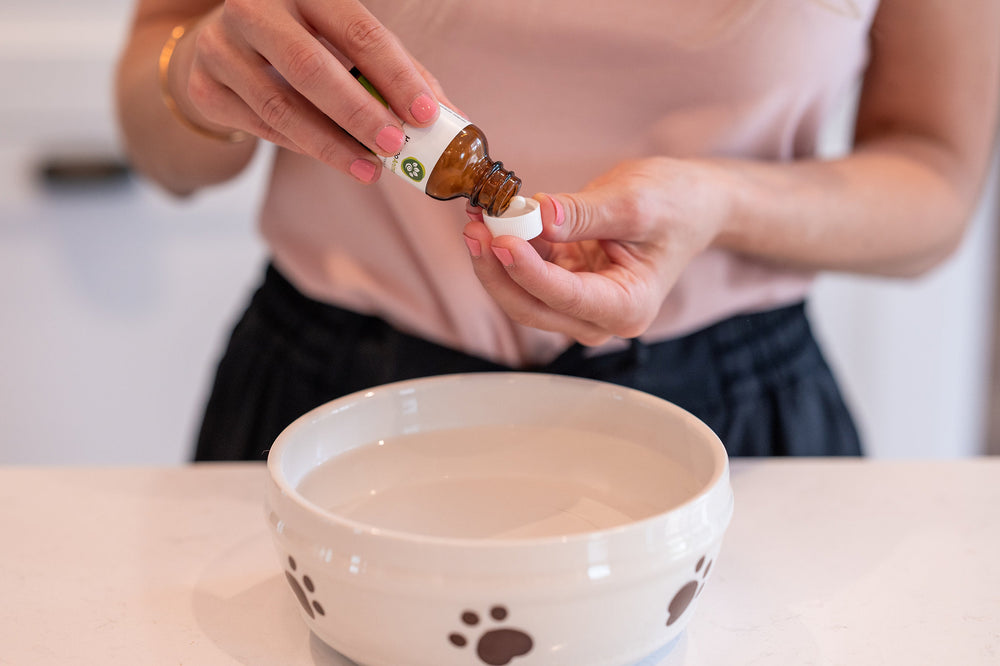The 4 Best Natural Remedies to Treat Low Blood Sugar in Dogs at Home
So you’re noticing that your dog isn’t as eager to play fetch or hide and seek these days. He barely touches his food, too. You also observe that your canine family member seems to be very thirsty most of the time.
Chances are your dog is suffering from low blood sugar. While some of the effects of low blood sugar in dogs can be rather subtle, this health issue can lead to very serious or even fatal consequences if not immediately addressed in the proper way.
- Click to learn more : 👉 NATURAL PRODUCT to maintain ideal BLOOD GLUCOSE LEVELS in your dog’s body 🐶
Guided by our more than a decade’s worth of knowledge and experience in holistic medicine, my team and I at Zumalka by HomeoAnimal would like to share with all pet parents and animal lovers worldwide how to properly deal with low blood sugar in dogs using natural means.
Let’s begin our discussion by finding out what exactly low blood sugar in dogs is…
What is low blood sugar in dogs?
Low blood sugar in dogs—or hypoglycemia as it is technically referred to—takes place when a dog’s blood sugar level reaches a glucose concentration of 3.3 mmol/L (60 mg/dL) or below.
Since a dog’s body uses glucose as fuel to work properly, having low blood sugar leaves the cells deprived of much needed energy and may cause some disruptions in his overall physiological functions.
Unlike what a lot of people mistakenly believe, though, low blood sugar in dogs is not a disease in itself. It is actually a reaction of a dog’s body when ingesting certain chemicals as well as some underlying health conditions.
Just to emphasize, these physiological disruptions can be anywhere from minimal like a decreased eagerness to play to extremely serious such as sudden collapse and seizures. Take note that in very extreme cases, low blood sugar in dogs can even be fatal.
Now let’s discuss the causes of low blood sugar in dogs…
What causes a dog to have low blood sugar?
There are a number of factors that can set off low blood sugar in dogs, which we are going to walk through in detail below:
Low insulin production in a dog’s body
One of the most common causes of dog hypoglycemia is when a dog’s body fails to produce enough glucose to supply much needed energy to the cells.
This can be predominantly observed among young puppies whose glucose production levels aren’t that stabilized, as well as senior dogs suffering from age-related illnesses that prevent their bodies from producing sufficient amounts of glucose.
Moreover, studies show that low insulin production is rather prevalent among toy breeds such as the Shih Tzu, Yorkshire Terrier, Chihuahua, Pomeranian, Pug, Lhasa Apso, Pekingese, as well as Bichon Frise.
Excessive consumption of glucose in a dog’s body
A few dogs tend to use up elevated levels of glucose during vigorous bouts of exercise or some other strenuous activity, which leads to low blood sugar. However, this typically happens if their meal times are also constantly delayed.
While any dog can be prone to this accelerated consumption of glucose, this characteristic is often observed in inherently energetic breeds like the Belgian Malinois, Jack Russell Terrier, Border Collie, Dobermann, Australian Shepherd, Irish Setter, and Boxer.
Unnecessary insulin given to a dog
Although this may sound counterproductive, diabetic dogs who are given excessive doses of insulin may experience a drastic plunge in their blood sugar levels.
Insulin basically works by regulating the amount of glucose in the blood. If a dog’s body senses that there is a lot of insulin present, it automatically lessens the amount of glucose in the bloodstream as a response, which can lead to low blood sugar levels.
This is the reason why administering insulin to a diabetic dog should be a really thought out process and not a reckless exercise since the consequences could be deadly.
Extreme levels of exercise
Despite the fact that regular exercise is essential to keep your canine family member in tiptop shape, overdoing it in terms of the intensity and duration can lead to the onset of low blood sugar in dogs.
Apart from giving your dog sufficient time to rest before and after exercise, ensuring that his meals won’t be delayed—especially during high-intensity workouts like agility training—helps stabilize his blood glucose levels so they won’t go below the normal threshold.
Ingestion of chemicals
Did you know that there are certain products found inside your home that can cause canine hypoglycemia? The most prominent examples of these are antifreeze and artificial sweeteners like xylitol, which can set off decreased kidney function or even acute kidney failure in dogs.
When a dog has kidney issues, his body won’t be able to regulate insulin levels properly. This means that the glucose levels in his bloodstream could either be too high or too low, which could result in low blood sugar in dogs.
Underlying health issues
As we have stressed earlier, dog hypoglycemia could be triggered by particular underlying health issues that can prevent your canine family member’s body from keeping his blood sugar levels ideal.
These health issues include Addison’s disease, liver dysfunction, pancreatic tumor, sepsis, malnutrition, as well as certain cancers such as malignant melanoma, leukemia, and metastatic liver cancer.
Next, let’s touch on the indicators of low blood sugar in dogs…
What are the symptoms of low blood sugar in dogs?
Below are the most common symptoms of canine hypoglycemia:
- Sudden loss of energy and drive
- Confusion and delayed stimulus response
- Sluggish movement with trembling or muscle spasms
- Sudden loss of appetite
- Accelerated breathing and heart rate
- Weakness or even paralysis of the limbs
- Impaired vision
- Seizures
- Fainting
It is crucial that you seek veterinary help as soon as you observe two or three of these symptoms of low blood sugar in dogs to avoid aggravating this health issue. Alternatively, you can also go for the best natural remedies for canine hypoglycemia, which we will cover in just a few moments.
Let us discuss the length of the effects of low blood sugar in dogs…
How long does dog hypoglycemia last?
The effects of canine low blood sugar can linger anywhere between 24 to 72 hours, depending on the affected dog’s age as well as his overall health and wellness. Interestingly, dogs that are suffering from other health issues may significantly take a longer time to stabilize their blood sugar levels.
Moreover, a dog that is suffering from insulin overdose may also experience longer episodes of hypoglycemia in dogs. It is crucial to take note that the higher the overdose is, the longer the effects of canine hypoglycemia will persist.
Next, we’ll tackle the toxins that can set off dog hypoglycemia…
What toxins cause hypoglycemia in dogs?
There are two (2) prominent toxins that have been seen to trigger low blood sugar in dogs, namely ethylene glycol, a type of compound that is mainly used for its water absorption properties, and xylitol, which is a sugar-free sweetener.
Although traces of ethylene glycol can be found in a variety of products such as cosmetics, detergents, and windshield de-icers, it is perhaps well-known as a key ingredient in the manufacture of radiator antifreeze.
As for xylitol, it is often added to commercial jams and jellies, breath mints, candies, peanut butters, mouthwashes, and chewing gums. This substitute sweetener is used to help curb obesity and diabetes.
What makes both ethylene glycol and xylitol attractive to dogs are their inherent sweet taste. However, as we have previously discussed in the causes of canine low blood sugar, these substances can disrupt the normal function of the kidneys, which can drastically make the amount of glucose in the bloodstream plummet.
Now we’ve got that covered, let’s answer a question that we have been asked by dog parents already when it comes to canine hypoglycemia…
Should I give my dog sugar water when he has low blood sugar?
The short answer is yes.
The most straightforward way of making sugar water if your dog is suffering from canine hypoglycemia is by mixing a level tablespoon of sugar with one glass of water. Make sure you stir the mixture thoroughly until all of the sugar is dissolved.
Depending on the size of your canine family member, give him a couple of teaspoons (in the case of toy and smaller breeds) or tablespoons (with regard to medium-sized and large breeds) of sugar water every half hour when you notice that he is going through the symptoms of low blood sugar in dogs.
You can also make use of a syringe to help your pet drink the sugar water if he is having trouble slurping the same.
Interestingly, sugar is not just your only option when making sugar water for dogs. Other alternatives that you can use include carob, stevia, coconut syrup, molasses, as well as maple syrup.
Next up, let’s have a walkthrough of the best home remedies for low blood sugar in dogs…
How can I treat my dog’s low blood sugar at home?
In case you’re noticing that your canine family member is experiencing the symptoms of dog hypoglycemia, here are the best natural remedies that you can use:
Honey stimulates the body’s glucokinase or “glucose sensor.”
A study published in the National Center for Biotechnology Information (NCBI) reports that besides having natural sugars to help the blood glucose level stabilize, honey also has the ability to stimulate the body’s glucokinase or “glucose sensor” to optimize insulin production in the pancreas.
Additionally, the study highlights that glucokinase “plays a key role in the liver’s uptake and storage of glucose as glycogen.”
To use honey as a home remedy for low blood sugar in dogs, directly dab a small amount of this natural sweetener all over your canine family member’s gums as soon as you notice that he is experiencing the effects of hypoglycemia.
On the other hand, you can also use honey as a substitute for sugar when making sugar water.
Apples contain a rich amount of carbohydrates that can be quickly transformed into blood glucose.
According to the National Institute of Diabetes and Digestive and Kidney Diseases (NIDDK), apples are loaded with carbohydrates that the body can quickly transform into glucose as soon as they are digested.
This key attribute makes apples a handy home remedy in emergency situations where your canine family member is suffering from the effects of low blood sugar in dogs.
To use apples as a home remedy for canine hypoglycemia, make sure you first remove the core and seeds, and then extract the juice using a blender, food processor or a juicer. You can either give the juice to your straight or integrate it with his regular meals.
Bananas contain natural sugars that are easily absorbed and raise blood glucose levels quickly.
The University of San Francisco Health shares that bananas have been found as one of the dog-safe foods that can be easily absorbed by the body and “will raise blood sugar levels quickly.”
It was also emphasized that the blood glucose raising capability of bananas is far greater when compared to foods that are abundant in protein and fat like bread, crackers, cookies, ice cream, candy bars, and even chocolate.
To use bananas as a home remedy for low blood sugar in dogs, mash it thoroughly until it takes on a squishy—but not runny—texture. You can directly serve it to your canine family member when the symptoms of low blood sugar in dogs get in the picture.
Pineapples have a greater effect on blood glucose levels compared to other fruits.
As revealed by Medical News Today, pineapples have an almost perfect balance of glycemic load and water content, which makes it easily absorbed by the body without making blood sugar levels skyrocket.
Moreover, its rich mineral content, which includes zinc, calcium, iron, magnesium, potassium, and manganese, will also help improve the overall digestive health of your canine family member.
To use pineapple as a home remedy for dog hypoglycemia, carefully peel and core the fruit and throw it in a blender, food processor, or juicer. Strain the liquid to get rid of the stringy bits. You can give this directly to your beloved pet or mix it with his water.
And now here’s a high-quality natural product that you should consider having in your dog home care kit when it comes to canine low blood sugar
A natural product you should consider including in your dog home care checklist
 TONICPET #10 is a natural and high-quality product that’s designed to promote balanced acidity levels in your dog’s body to maintain ideal blood glucose levels.
TONICPET #10 is a natural and high-quality product that’s designed to promote balanced acidity levels in your dog’s body to maintain ideal blood glucose levels.
A study published in the National Center for Biotechnology Information (NCBI) reveals that there is an “inverse relationship between blood glucose and acid output.” It further explained that “low glucose levels were associated with high rates of acid secretion” and “high glucose levels were associated with low acid secretion.”
Made from Natrum phosphoric, TONICPET #10 basically helps keep your dog’s blood sugar in its best possible levels, which in turn, impedes the possibility of making him prone to canine hypoglycemia. Moreover, this product also helps with the proper functioning of the digestive tract and joints.
To use TONICPET #10 as a home remedy for low blood sugar in dogs, crush the recommended number of pellets and add them to your canine family member’s food or water twice a day.
Below are the corresponding number of TONICPET #10 that should be used depending on your dog’s weight:
- 0-25 lbs: 1 pellet
- 25-50 lbs: 2 pellets
- 50-75 lbs: 3 pellets
- 75 lbs+: 4 pellets
If you’re still having a difficult time choosing a natural and high-quality product that’s designed to keep canine low blood sugar in check, TONICPET #10 is definitely one you should consider.
Now let’s touch on the frequently asked questions (FAQ’s) about low blood sugar in dogs…
FAQs You Should Take Note Of
How often do you feed a dog with low blood sugar?
Interestingly, there is no difference between the frequency of the meals of a dog that is prone to canine hypoglycemia and one that is not at risk of the same.
However, if your dog is suffering from low blood sugar, the general rule is that you should stick to regular and consistent meal times to prevent the glucose levels in his bloodstream from unexpectedly plummeting.
Should I exercise my hypoglycemic dog?
The short answer is yes.
But it is crucial to always set a specific activity timeframe for your canine family member to avoid exposing him to prolonged and intense exercise that can lead to low blood sugar in dogs.
It is also recommended to only put a hypoglycemic dog through light to moderate exercises like walking, swimming, and playing catch. Intense workouts like agility training should be avoided.
Can canine hypoglycemia be passed from one dog to another?
No, canine hypoglycemia is not a transmissible disease. No amount of contact can lead to the passing on of this health issue from one dog to another.
Conclusion
I hope you learned a lot from this blog post on how to treat low blood sugar in dogs at home. It is important to remember that dealing with this condition isn’t a hit-or-miss affair.
Furthermore, if you’re worried about other health issues that may be affecting your beloved dog, signing up for our newsletter below will surely help. Besides getting tips and recommendations from our Natural Health Advisors, you will also be guided through the products and treatment options that best fit your animal's health needs.






Hi Amy,
I’m so sorry to hear about your dog, that’s such a difficult thing to have to go through.
I have sent you a private email so that we can give you some free suggestions to help him out.
I hope that he can be on the mend soon!
Zumalka
My 11 year old lab mix has been diagnosed with insulinoma. I would love to hear the same advice you gave to Tracey to support him. Thank you!
Dear Tracy,
I am so very sorry to hear about your poor dog. I know this is very difficult for you both. For sure the tips in this article can help with the blood sugar issue, however, the reach will be limited unless we also work on the root cause…. the cancer cells. So, to help you with a more targeted solution for your dog, we have sent you a private email so we can give you some free suggestions.
I hope your dog feels better soon!!
Zumalka
Hi my 5 year old boy (border collie ) has been diagnosed with insulinoma.. we have had it removed but biopsy revealed there is cancer cells still on the other side of the pancreas , which lowers his blood sugar levels , will this help?
Hi Jeanette,
Thank you so much for your comment!! We do ship to New Zealand!
We have sent you a private email to help you with your pet’s specific needs and symptoms.
We look forward to working with you to help get you pet back to optimal health naturally!
Zumalka
Leave a comment